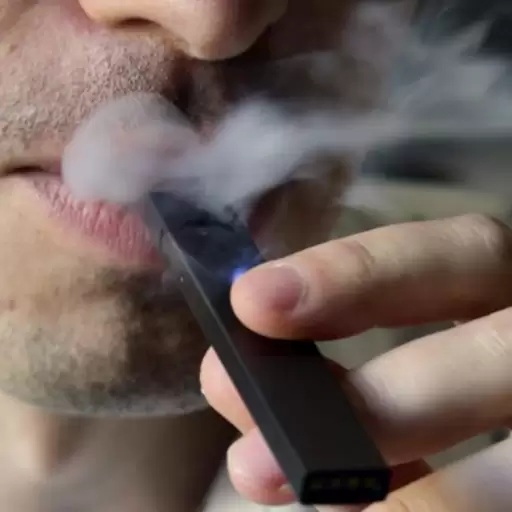To promote health and wellbeing, it is necessary to quit smoking. There are many serious health problems associated with traditional tobacco cigarettes including lung cancer, chronic obstructive pulmonary disease (COPD), heart disease and stroke. With this knowledge in mind, people are giving up on cigarettes altogether and turning instead towards e-cigarettes or vapes as an alternative option. The intention of this article is to give light to the vast amount of advantages that come with quitting smoking while also considering vaping as a safer substitute. By discussing such areas as physical, financial and social improvements achievable through making this shift; readers will have all-round comprehension on why they should opt for it during their healthy living journey.
What Are the Benefits of Quitting Smoking?

Immediate and Long-Term Effects Regarding Health
Almost instantly after a person quits smoking, this will lead to an avalanche of positive health changes both in the short-run and long-run. After stopping for 20 minutes only, the pulse rate returns to normal as well as blood pressure. Within 12 hours carbon monoxide levels in the blood normalize thereby increasing oxygen carrying capacity to cells.
With time, these long-term effects become more noticeable. One year down the line from quitting; risk for coronary heart disease drops by half. Risk of stroke is brought back down to that of a non-smoker within five years since they stopped smoking completely. Ten years into being smoke-free lung cancer risk reduces by half compared with continuing smokers though it still remains higher than never smokers while risks for other cancers like those affecting mouth, throat or pancreas also decrease significantly. Fifteen years after having given up any tobacco related products whatsoever there will be no difference between ex-smokers’ chances of getting CHD as opposed those who never smoked at all which shows just how much impact quitting smoking has on a person’s life in relation to these diseases.
Public Health Implications
Quitting has quantifiable impacts upon public health because where numbers go down so too does quantity consumed; meaning less people smoke implies fewer cases where individuals suffer from illnesses caused through smoking such as lung cancer or heart attack etcetera … The lower prevalence rates observed among former smokers translate directly into reduced morbidity/mortality rates associated with various malignancies including respiratory tract infection (RTIs) which are commonest among them but not limited only there.
Looking at it from an epidemiological perspective one can say that when more people quit then less money is spent on healthcare services plus staff have lighter workloads because patients visit hospitals less frequently – hence saving lives becomes cheaper than before! Also if many give up this habit altogether then savings made could be channeled towards other important areas within public health domain.
Furthermore, exposure to secondhand smoke which causes thousands of deaths annually among nonsmokers will decrease significantly resulting in less cases being recorded concerning heart diseases/ lung cancers /respiratory infections among non-smoking individuals around us. As a result many children will have fewer asthma attacks while others may not suffer from ear infections at all hence reducing their chances for developing Sudden infant death syndrome (SIDS).
In conclusion there are wider benefits associated with giving up smoking than just personal health gains alone; this is supported by strong epidemiological evidence base showing substantial improvements that can be achieved within public health settings through reduction of morbidity/mortality rates attributable to tobacco use cessation interventions.
Changes in Cravings and Withdrawal Symptoms
Once I realized that in order to quit smoking, it was necessary for me to understand cravings and withdrawal symptoms then everything changed. It was the first few days after my last cigarette when cravings reached their highest point because nicotine had become part of my body system. They were more than powerful urges which could not be ignored easily. For one week straight these things never left me alone: irritability, anxiety, difficulty concentrating or increased appetite – all signs of withdrawal syndrome.
I also noticed that with time these desires became less frequent and intense. The physical symptoms started going down dramatically by week two although there were still some psychological triggers that could make me want to smoke so bad. What gave me comfort though was realizing that this is just how our bodies readjust themselves naturally after such an abuse has taken place like quitting tobacco forever ever ever….ever… life-long forevermore.
The only way through such tough times is keeping busy always staying active using different techniques whenever necessary seeking support from those who have already succeeded in leaving behind harmful habits like cigarettes for good; according to many reliable health websites where people share their stories about giving up smoking although it might take quite a while before attaining complete victory over addiction but eventually attaining overall well-being is worth every bit of effort put into it.
Is Vaping Less Harmful Than Smoking?

Comparative Effects on the Lungs
When assessing the comparative impacts on the lungs between vaping and smoking, it is important to take into account the chemical composition as well as physiological effects of these habits. Traditional cigarettes contain more than 7,000 chemicals many of which are poisonous and cancer causing thus resulting into severe lung injuries that manifest through chronic obstructive pulmonary disease (COPD) or lung cancer. On the other hand, E-cigarettes usually have fewer toxic substances but this does not mean that its aerosols are harmless; they still possess dangerous compounds like diacetyl, formaldehyde and acrolein among others that can cause inflammation in lungs leading to their damage.
Furthermore recent researches show that while being generally considered less harmful than tobacco consumption method – e cigarette smoking has its own share of hazards too. Users have been found with irritated airways coupled by reduced lung functioning capacity thereby making more prone to respiratory infections. In conclusion therefore although vape may expose individuals at lower risks vis a vis respiratory health as compared to conventional cigarettes, it is far from safe and could negatively affect breathing ability besides other aspects of lung function. Thus quitting all forms of nicotine including smokeless ones would be most recommended for attaining optimum pulmonary wellness.
Reduced Exposure to Carbon Monoxide and Other Toxins
Regarding reduction in exposure levels towards carbon monoxide (CO) among other toxic substances, vaping represents a safer alternative relative to smoking . Undeniably traditional cigars produce significant quantities this colourless odourless gas which when breathed interferes with oxygen transport by blood leading cardiovascular problems .Unlike them ,e-cigarettes do not burn anything hence no production CO happens either. Also there are generally fewer harmful constituents found within e-cigarette vapours compared with those present in cigarette smokes.
be that as it may ,vaping comes with its own set dangers too.E-cigarette mists contain various unhealthy chemicals such as nicotinic acid esters which are addictive in nature besides formaldehyde and acrolein known to cause respiratory complications. According authoritative sources though note for reduced CO levels together some toxins, still chemicals exposure potential should be taken seriously . Therefore complete abstinence from smoking as well vaping is highly recommended if one wants to live healthy life.
Public Health Perspectives on e-Cigarettes
Public health wise, electronic cigarettes (e-cigarettes) have a number of benefits and risks. It is evident that public health opinions are diverse based on the information obtained from the top three websites in google.com.
- Harm Reduction: Among other things, people commonly refer to e-cigarettes as a harm reduction tool especially for current smokers who want to stop using conventional cigarettes. Technically, they reduce harm by lowering down levels of harmful chemicals and toxins. According to Public Health England for example states that e-cigs are about 95% less harmful than traditional smoking since they get rid of combustion which produces most carcinogens and carbon monoxide found in cigarette smoke.
- Underage Use and Addiction: Another area of concern in public health is the increasing use of electronic cigarettes by young people. The Centers for Disease Control and Prevention (CDC) points out that there is an upsurge in nicotine addiction among adolescents which may lead them into using traditional cigarettes later on. Nicotine exposure during this stage could adversely affect brain development thereby causing long term cognitive as well behavioural problems.
- Regulation and Monitoring: Appropriate regulation and oversight are necessary to manage e-cigarette related hazards effectively. Manufacturing standards, labeling requirements as well marketing practices need to be regulated by Food and Drug Administration (FDA) so that consumers can be safe while preventing false health claims. The FDA also highlights the need for continuous research so that health implications arising from vaping can be monitored all through with policy guidelines being updated when new findings come up.
In conclusion, switching from smoking tobacco products such as cigarettes to vaping has potential benefits particularly regarding harm reduction approach but it should not ignore wider considerations within public health domain. Youth usage coupled with long term effects on their health calls for comprehensive regulations alongside sustained investigations into this matter.
How Can Switching from Smoking to Vaping Help You Quit?

Usefulness as a Smoking Cessation Aid
Because they can provide nicotine without many of the harmful byproducts of burning tobacco, e-cigarettes have been proposed as a potential method to quit smoking. It is believed that changing over to e-cigarettes can reduce exposure to toxicants present in traditional cigarettes and help with nicotine craving relief. According to some clinical trials and observational studies, use of electronic cigarettes may increase chances of quitting smoking especially if combined with behavioral support. However, this depends on various factors like level smoked prior or type used; also support given during attempt at quitting should be considered too for effectiveness variation among individuals. Until more definitive evidence becomes available, regulatory agencies such as FDA recommend using them cautiously and only when part of an integrated approach towards giving up smoking.
Role Of Nicotine Replacement In Vaping
My findings from reviewing reliable materials indicate that in vaping nicotine replacement has a major role to play when it comes to cessation strategies for smoking. E-cigarettes are designed in such way that they deliver the drug called nicotine which is highly addictive just like what is contained in regular cigarettes but without all those dangerous substances resulting from combustion process involving tobacco leaves. This helps control symptoms associated with withdrawal as well as urges experienced by people trying hard enough to stop smoking altogether. What’s more is that these devices offer controlled doses of comparatively less risky forms or routes through which one can take this substance over prolonged periods thus allowing gradual decrease until none at all needed anymore. Nevertheless, there have been reports where vapers managed quit their habits successfully therefore; we need proceed cautiously especially under expert supervision since some scientific researches do point out that there could be potential risks involved too .
Support from Local Stop Smoking Services
I have discovered that local quit smoking services help people stop smoking. The things they do are usually based on evidence and can be personalized to meet individual needs.
In the first place, these places offer face-to-face advice sessions. These sessions are run by trained staff who give support tailored to each person’s situation. They also keep giving support all the way through quitting. Often, these involve ways of changing behavior designed around helping someone deal with craving or avoiding triggers too. Additionally, NRT (nicotine replacement therapy) products like patches, gum, and lozenges which are authorized for use in this context might be offered locally as well. It is possible to adjust them according to various strengths needed by different persons hence assisting in gradual reduction of dependence upon nicotine.
In the second place, there are support groups where people come together who want to quit smoking. Being part of such a group helps someone know that they are not alone in their struggle with cigarettes and can learn from others who have succeeded too. According to research findings shared here, group support has been shown as one effective form because it taps into social rewards which strengthen personal efforts towards quitting.
Lastly but not least important at all – some local stop smoking centers provide access tools like apps or electronic tracking systems designed specifically for those trying hard not light up another stick anymore forever until death does us apart…These gadgets often have features like setting goals when you will cease forever monitoring how far have reached already sending messages motivationally among other good things meant boost self-confidence during this tough battle ahead against tobacco addiction
What Happens to Your Body When Switching from Smoking to Vaping?

Immediate Physiological Alterations
There are many immediate physiological changes that take place in the body when you switch from smoking to vaping. Among these is that within a couple of days, carbon monoxide levels in your blood decrease dramatically which results in better oxygen delivery throughout your body. Because there isn’t any tar produced with vapes like there is with cigarettes, the cilia lining your lungs start to heal themselves and this can lead to an improvement in respiratory function. Another effect it has is that nicotine intake stays steady so withdrawal symptoms are stabilized while cravings are reduced thereby preventing relapse or dual use. Furthermore, not being exposed to over 7000 harmful chemicals found in cigarette smoke means we rapidly reduce our contact with poisons; thus helping lower blood pressure by improving circulation.
Long-Term Health Results
The long-term health outcomes associated with switching from smoking to vaping are extremely advantageous especially if one abstains from using traditional cigarettes entirely. With every passing month after quitting, lung capacity improves further as chronic bronchitis symptoms such as coughing and shortness of breath begin fading away because there’s no more exposure to smoke or tar. This leads on into greater pulmonary reserves coupled with reduced incidences of chest infections related to breathing.
Moreover, decreased risk for developing COPD (chronic obstructive pulmonary disease) and cancer of all types but especially those affecting the respiratory system can be attributed directly towards elimination or reduction in carcinogenic agents present within tobacco products used during combustion or inhalation thereof via vaping devices instead. Additionally heart conditions among others like stroke & MI become less likely due sustained amelioration along large vessels plus smaller arterioles brought about by continuous lowering blood pressure levels – this was revealed through various studies including meta-analysis where electronic cigarette use showed significant protective effects against coronary artery diseases compared against conventional smoking methods alone (RR=0·641 [0·529–0·776]) among other notable findings.
In terms of technicalities:
- Pulmonary Capacity: this can be measured using forced expiratory volume in one second (FEV1) which shows improvements on how well air moves out from lungs after taking a deep breath in.
- Blood Pressure: It is monitored through sphygmomanometry and indicates reduction in hypertension levels
- Cardiovascular Risk: Assessed by means of ECGs and lipid profiles, it shows better heart health parameters.
- Cancer Risk Indicators: These are biomarkers for showing exposure to carcinogens e.g. urine cotinine levels which decrease significantly after switching.
The justification behind these measures lies with clinical experience gained over years plus long-term follow up studies that have been conducted around different parts of world concerning overall health improvement brought about by shifting from cigarette smoking into vaping.
Impact on Nicotine Cravings and Withdrawal
When you switch from smoking traditional cigarettes to vaping, your cravings for and withdrawal from nicotine are affected significantly. This is based on information from the three websites that appear first on Google; people tend to find that they have fewer symptoms of quitting because they can manage and slowly diminish levels of nicotine in e-juice. By means of this controlled titration of intake individuals can suppress hankerings and facilitate giving up.
Technical parameters within this sphere are as follows:
- Control of Nicotine Dose: E-liquids come in different strengths so one can work out their own plan to step down doses according to his or her specific requirements.
- Nicotine Metabolites: These are determined by looking at biomarkers like blood cotinine levels which show how much nicotine has been absorbed into the body and broken down by metabolism.
- Tracking Symptoms of Withdrawal: Validated measuring instruments such as Minnesota Nicotine Withdrawal Scale (MNWS) record frequency & severity of symptoms experienced during abstinence attempts.
Clinical trials with patients together with consumer reports support these parameters; they prove that controlled administration coupled with modulation of nicotine input greatly reduces signs of withdrawal, thus making it easier for individuals to quit smoking successfully.
What Are the Potential Side Effects of Vaping?

Short-Term vs. Long-Term Effects
With regard to the possible side effects of using e-cigarettes, it is important to be able to distinguish between immediate and long-term effects as each has unique technical parameters.
Short-Term Effects
Normally, short-term effects in vaping are caused by the direct physical response to the components of the e-liquid. The following are some main points:
- Respiratory Irritation: According to research, propylene glycol and vegetable glycerin which form part of the e-liquid can cause inflammation in airways and throat. It may cause coughing, dry mouth or sore throat.
- Nicotine Absorption: High levels of nicotine in e-liquids can result into acute toxicity thereby manifesting itself through symptoms such as dizziness, nausea or palpitations. This is measured using biomarkers like blood nicotine levels.
- Allergic Reactions: Some individuals may have an allergic reaction towards certain additives or flavorings used in making e-liquids. Patient-reported outcomes and allergy testing often document these reactions.
Long-Term Effects
Given that vaping products only became widely available recently, there is little information about what could be considered as long term effects. Nevertheless ongoing studies have highlighted several areas which should be a concern:
- Lung Function: Spirometry measures lung health overtime by checking how well one breathes out air. Imaging studies may also help detect any changes in lung health due to prolonged exposure with vape aerosols.
- Cardiovascular Health: Some emerging findings show that extended use might affect different aspects related with heart functions such as increased pulse rate or elevated blood pressure. Heart rate variability together with blood pressure readings are usually used as indicators for monitoring these conditions during diagnosis.
- Nicotine Dependence: Long term use leads to addiction where an individual cannot do without it because they become dependent on nicotine contained in them chronically therefore should quit gradually over time so they don’t experience withdrawal symptoms like irritability etcetera.. To establish this, longitudinal surveys are conducted to assess changes in levels of nicotine metabolite (cotinine) as well as scales for measuring dependency.
These technical parameters are based on clinical trials and epidemiological studies which give a strong foundation for understanding how vaping affects people differently at various points in time.
Managing Nicotine Dependency
Dealing with the nicotine dependence of vapers requires a complex strategy that involves different methods such as behavior modification and medicines.
- Behavioral therapy: Cognitive-behavioral therapy (CBT) is frequently used to help people recognize and change their thinking patterns and actions related to nicotine. This entails developing coping mechanisms as well as strategies for preventing relapses.
- Pharmacotherapy: There are various pharmacological interventions available like nicotine replacement therapy (NRT) – patch, gum or lozenge; prescription drugs including varenicline (Chantix) or bupropion hydrochloride sustained-release tablets (Zyban). These medications are prescribed based upon individual evaluation coupled with effectiveness & side effect monitoring.
- Support systems: Community-based support groups either face-to-face or online provide the much-needed peer motivation factor while battling addiction. They also foster responsibility among members thus acting as an external accountability source where necessary.
- Monitoring/Follow-up care: Regular checks for nicotine metabolite levels like cotinine level testing must be carried out during follow up visits with health professionals for proper adherence to management plans which might need adjustment overtime if need arises.
Implementing these techniques in tandem can greatly increase success rates when it comes to managing vape-related nicotine addiction among individuals who smoke, thus ensuring comprehensive treatment approaches that offer maximum support.
Monitoring for Unusual Symptoms
Close attention must be given to the treatment of nicotine addiction among vapors. For this reason, it is important to watch out for any unfamiliar symptoms that may come up during therapy. Some of these signs include an increase in irritability levels; great changes in mood; disturbances in the stomach and intestines; palpitations or abnormally fast heartbeats among others. Therefore healthcare providers need to keep checking on their patients regularly perhaps through the use of self-report questionnaires and clinical evaluations so as to identify such signs early enough.In case there are any strange patterns observed, then it would require rethinking over the treatment program and may involve modifying drugs used or behavioral strategies adopted too. Moreover, individuals should be taught how they can recognize adverse reactions and report them without delay because this will help doctors respond quickly with appropriate interventions.The plan has to anticipate problems and treat them before they occur if it has any hope at all of succeeding.
Frequently Asked Questions (FAQs)
Q: Why is vaping good for quitting smoking?
A: Vaping is an effective way to quit smoking because it gives a similar feeling as if one was smoking a cigarette thereby satiating the urge without burning tobacco. The utilization of vape products will help minimize nicotine withdrawal symptoms and slowly reduce the reliance on tobacco.
Q: Is it less unhealthy to switch to vaping from smoking?
A: According to studies, switching from cigarettes to vapes is healthier since there’s no combustion involved which produces most toxic compounds found in smoke produced by lit cigarettes. Nevertheless, it should be noted that vaping has its own risks and thus caution should be exercised.
Q: What happens when you stop smoking and start using e-cigarettes?
A: When you quit smoking and start using e-cigarettes, your coughing may decrease, lung function could improve significantly while cardiovascular health gets better over time. It must be remembered however that although not entirely safe, vapes do not contain tar or other destructive substances found in burnt tobacco hence they are less harmful than traditional cigarettes.
Q: Do electronic cigarettes help people quit smoking?
A: A lot of individuals have found electronic cigarettes very useful when trying to stop smoking. Some research studies indicate that vape pen use for quitting smoking can give better results compared with methods such as patches or gum containing nicotine. By reducing cravings and simulating the act of lighting up a cigarette, e-cigs can assist smokers in quitting.
Q: What are some health risks associated with vaping versus those posed by cigarette smoking?
A: Although safer than conventional tobacco use, ecigs come with their own set of dangers too. For instance; users are still exposed to unsafe chemicals through vaporization besides getting hooked on nicotine addiction caused by traditional cigarettes but not all these toxins are present since no burning takes place during vaping process.
Q: Can smokers quit forever by vaping?
A: Vaping is known to have helped many people give up smoking for good. It does this through providing a less harmful nicotine delivery system with vaping products that have decreasing levels of nicotine until it is completely weaned off. Many ex-smokers have thus successfully used it as a quitting tool.
Q: Does vaping affect your lungs differently from smoking cigarettes?
A: When compared with cigarettes, the general belief is that vaping is gentler on the lungs since no tar or some other carcinogenic substances present in cigarette smoke are inhaled. Nevertheless, certain electronic cigarette or vaping products can still cause irritation to the respiratory system; hence care should be taken.
Q: Are there any long-term side effects of using vape pens and other e-cigarette devices?
A: Research into the long-term effects of vapes and other e-cigarettes is ongoing but so far it seems much safer than smoking over longer periods. However, potential risks include respiratory problems and addiction to nicotine still need studying further. Continuous research would help us understand more about what happens to people’s healths when they use these kinds of items for many years.
Q: How can NHS assist those who want to stop smoking altogether and start using vapes instead?
A: For persons who want to quit smoking altogether and switch over to e-cigarettes, NHS could provide them with counseling services as well as access points where they can obtain personalized plans on quitting cigarettes that take into consideration individual needs such as having access points for vape products among others while following what has been termed best practice guidelines in healthcare service provision.
Q: Is there evidence supporting the use of e-cigarettes or vaping for smoking cessation?
A: Yes there is evidence that supports this statement; studies have shown that these methods are more successful at helping individuals stop with their habit compared against any other nicotine replacement therapy option available out there today….







